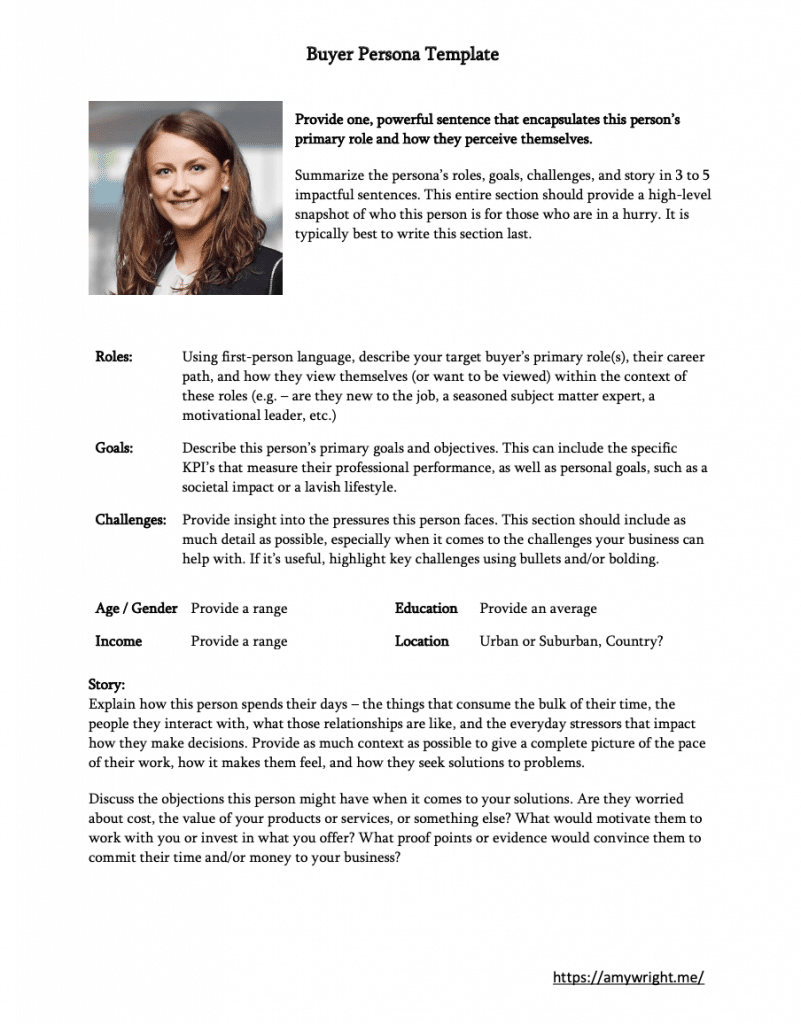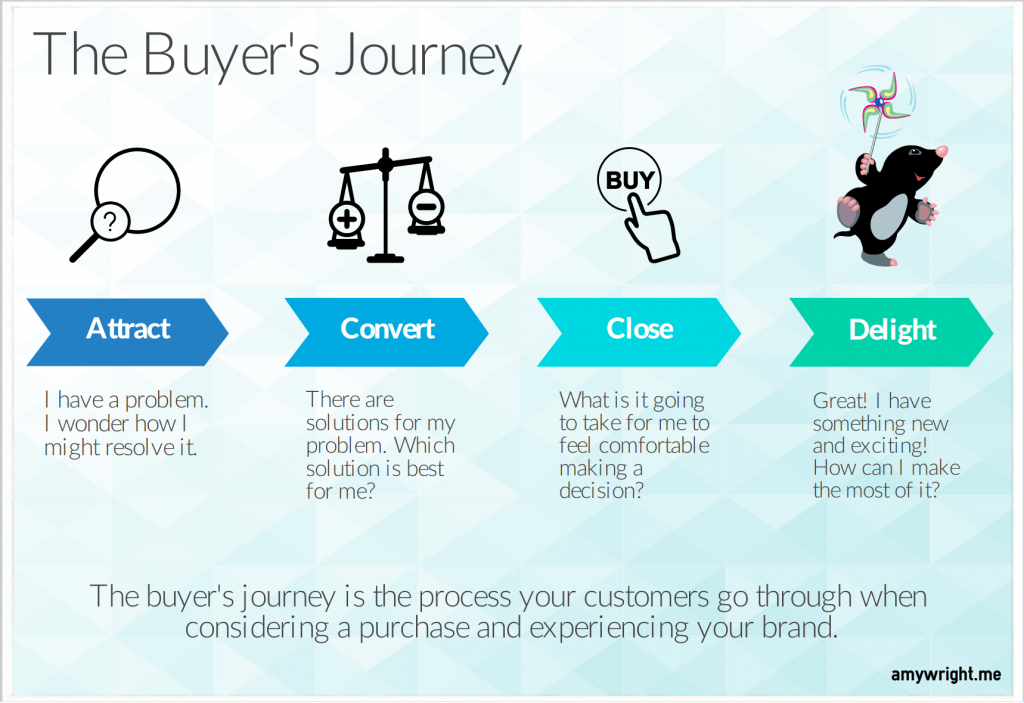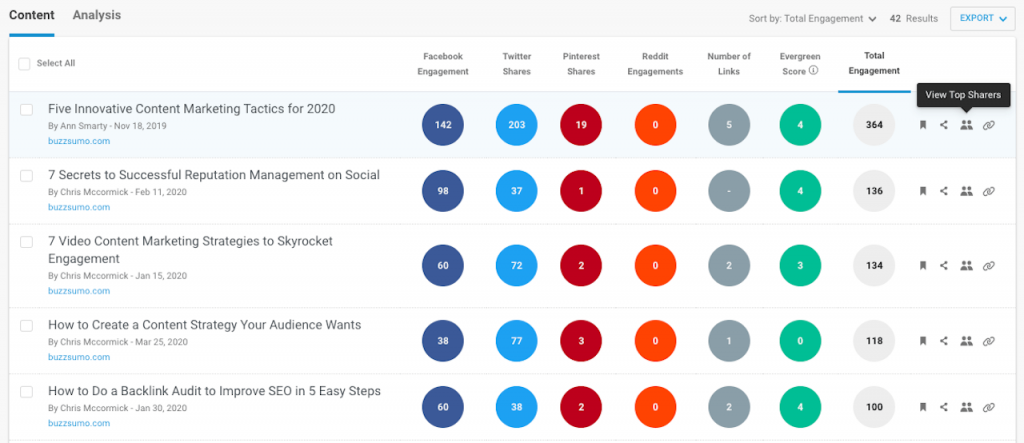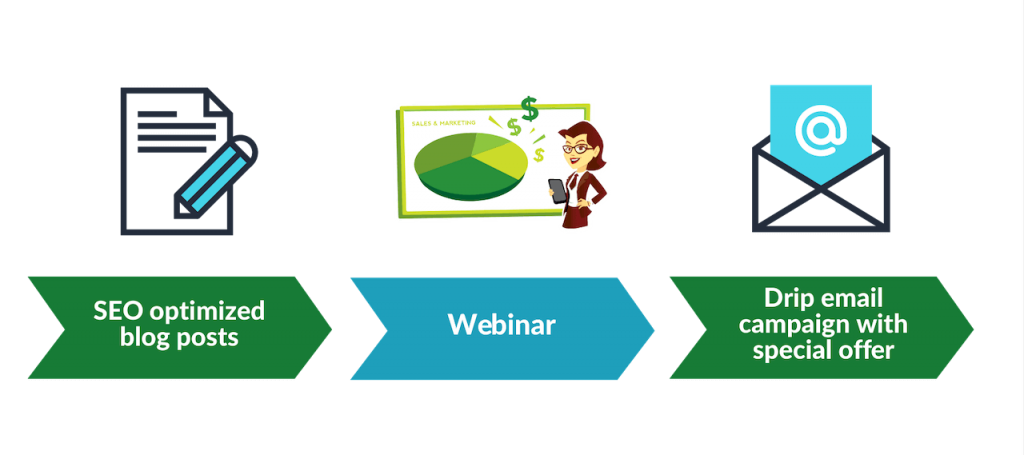
You wouldn’t go on a road trip without fuel and a map, would you? Of course not. Because you’d never arrive at your destination. Likewise, if you wish to gain recognition, traffic, and leads from your content marketing efforts it’s critical to learn how to develop a content marketing strategy.
Each year the Content Marketing Institute surveys content marketers to learn about their work. And the research consistently shows that “a documented strategy is often a key indicator of content marketing success.”
Why? Because a documented content marketing strategy gives you the information you need to drive results.
What is a Content Marketing Strategy and Why is it Important?
A content marketing strategy is a document (or set of documents) that describes how you plan to attract and engage your target customers with content. It typically includes an analysis of your customers and the types of information they’ll need as they look for solutions to problems you can help them solve. It will also discuss your business goals and the role your content will play in supporting those goals. And, finally, it will outline your plans for building and distributing content given your available resources.
Creating a content marketing strategy is important for any business that produces content because, quite frankly, content is an investment. You’re investing time and resources into assets that will have a profound effect on how people experience your business.
When you set goals and craft content with intention, these assets can deliver a return on your investment, for years after you do the work. But if you create content haphazardly, it may have little effect at all, which makes it easy to get discouraged.
A content marketing strategy gives your work focus. Stating exactly why you want to create content and what you expect it to do for you, is powerful. It provides you with the insight you need to research, plan, and build great content that will inspire your customers to take action.
Ready to get started?
Here’s how to develop a content marketing strategy in 10 steps:
- Establish Your Goals and Objectives
- Get to Know Your Target Audience
- Perform a Competitive Analysis
- Assess Your Available Resources
- Conduct Topic and Keyword Research
- Document Your Strategies and Tactics
- Inventory and Audit Your Existing Content
- Build an Editorial Calendar
- Create and Promote Your Content
- Track Your Results and Make Adjustments
Now, before we go any further, I want to make something clear. Building a content marketing strategy is a cycle, not a process. When I help clients with their content marketing strategies, we start small by picking one or two areas of focus. Then we create and promote their content, track the results, and adjust our plans as we learn. I will walk you through each of these important steps below. But you and your consultant can adjust the order and revisit steps to accommodate the needs of your business.
Step 1: Establish Your Goals and Objectives

The first step in creating a content marketing strategy is to specify why you plan to create content. You may be familiar with the potential benefits of content marketing, such as increased website traffic, greater brand recognition, lead generation, and the opportunity to establish key players in your organization as “thought leaders.” But this is the time to think bigger.
What are the goals of your business and how do you expect your content to support the achievement of those goals?
This is critical for one simple reason. Certain strategies (like search engine optimization (SEO)) take time to deliver results and there will be ups and downs. You need to get clear on the realities of your business and when you need things to happen so you can build a plan that will get you where you need to go.
So, for your first step:
Open a document and name it “Content Marketing Strategy.” When we’re finished, this document will contain your goals, objectives, strategies, and tactics (sometimes referred to as GOST). But, for now, we’ll focus on the goals and objectives only.
Jot down your mission (who you serve and what you strive to do for them). Then describe what you’ve achieved so far and your high-level business goals for the coming year. Perhaps you’re looking to grow your customer base. Or, maybe you wish to increase revenue from your existing customers. Most likely, it’s a combination of things and this will influence your approach.
Next, move on to the objectives:
This is where you can be more specific. Explain exactly how your content will help the company meet its goals. If your goal is to gain new customers for a training course, for instance, your objectives may be to increase traffic coming to your website from content related to that training by 50% and to improve that traffic’s conversion rate by 20%.
For a few more examples take a peek at this post: 5 Content Marketing Goals That Will Boost Your Strategy.
Step 2: Get to Know Your Target Audience
Before you can craft content that can attract your target customers and inspire them to take action, you need to get to know them . . . deeply. A great way to do this is to a build buyer persona(s) and a buyer’s journey.
A buyer persona is a research-based, written profile that depicts a fictional target customer. You can gather the information you need by reviewing customer data or interviewing co-workers who interact with customers. You can also sit in on sales calls and/or interview (or survey) current or past customers. Ideally, you will use more than one method, because you’ll learn something new every time.
A completed buyer persona contains insights into who your customers are. It examines what their days are like, the things that concern them, and the things that motivate them, especially when it comes to your products and services. The format will vary, but a persona typically looks something like this.

A buyer’s journey, on the other hand, is a document that maps the customer’s experience as they identify a need or problem, research possible solutions, make their decision, and engage with your organization. It helps you to think through what your customers need from you at each step of their journey, so you can build content to address those needs. Here’s a simple infographic that describes each of the stages:

Completing this part of your content marketing strategy is an effort, but it’s worth it. It will help you identify gaps in your existing materials and plan content that will resonate with your target audience. Check out the following posts for more information about why and how to build these tools:
- What is a Buyer Persona and Why is it Important
- 42 Buyer Persona Questions to Inspire Your Research
- Why the Buyer’s Journey is the Hero of Content Strategy
Step 3: Perform a Competitive Analysis

Ah, competition. There’s nothing quite like it when you’re seeking inspiration. Spying on the competition can help you understand their strategic plans, the types of content that work best for them, and (most importantly) what you can do to set yourself apart.
When it comes to content marketing, however, competition can come from unexpected places. There are your market competitors, of course. The people or companies that sell similar products or services to yours and are competing with you for the same pool of customers. But there will also be competition from companies that offer something completely different, yet they’re competing for the attention of your market in search and on social media.
With your market competitors, set aside a few hours to take a peek at just a few of them. You can always come back and look at other competitors later. Examine their websites, messaging, reviews, etc. to gain a clear picture of the following:
- The strengths and weaknesses of their offering and websites in comparison to yours,
- How they’re positioning themselves in the market,
- The types of content they’re producing, and
- The content that has been most successful.
For items three and four, research tools make the work a lot easier. For example, with most SEO tools (like SEMRush and Ahrefs) you can enter a competitor’s website to gain insight into the amount of traffic they gain from paid and organic search. And you can also see which pages and keywords are responsible for that traffic.

If you’d like to see how your competitor’s content performs on social media, there are tools for that too. With BuzzSumo, for example, you can enter a competitor’s domain to get a report showing their most shared content. You can see who wrote it and who is sharing it, broken down by platform. And, finally, you’ll gain insight into their publishing schedule and the content formats that perform best.

When analyzing the competition in search, however, you’ll need to take it on a case by case basis. And, I would recommend saving this research for later.
When you’re ready to build content, set aside about an hour to examine the competition and to apply what you learn to the creation of an outline. Perform an incognito search in Google for the keywords you’re targeting, then review the content in the top positions. Notice how they approach the topic, the information they provide, the content format, and anything else that stands out. Then use what you’ve discovered to create something better. Much better.
Step 4: Assess Your Available Resources
By now you’re probably swirling with ideas and eager to get going, but first a reality check. Will you be planning, creating, and promoting this content by yourself, or with the help of a team? Do you have funds to promote your content or does it need to happen organically? Can you afford to hire freelancers and invest in some content marketing tools to make the work go faster?
Below are some of the roles and tasks involved in building content. You might have one person who can do many of these things, or (if you plan to create a lot of content) you may need help. Whatever your situation it’s important to be honest about your capabilities so you can set expectations and build a strategy to match.
- Content Marketing and/or SEO Strategist
By exploring how to develop a content marketing strategy, you’re doing this job now. - Content Marketing Management
This person owns the editorial calendar, assigns tasks, and keeps everyone in sync. - Subject-Matter-Experts (SMEs)
These people have the specialized knowledge you need for your content. - Writers and Editors
Professional-level writing is core to every content marketing strategy. - Image and Video Producers
Photos, infographics, and animation make content interesting and easier to consume. - Promotional Expertise
Remember, top-notch content is an investment. Nurture your success with promotion. - Webmaster or Developer Support
Someone must be responsible for keeping your website healthy and making changes. - Tracking, Measurement, and Reporting
You need someone on your team who is comfortable with analytics.
Step 5: Conduct Topic and Keyword Research
When setting goals and objectives, it’s easy to make grand statements like “We want to establish ourselves as thought leaders in our space and earn the number one position in search for “sales training.” And, this sounds really great until you type the term “sales training” into Google and see this:

Well, hold up. Maybe we need to be more specific.
Topic and keyword research involves examining the search terms you believe you should pursue and deciding what you should actually pursue based on the data. You make these choices by looking through the terms people type into Google to identify those that are relevant to your target audience and that you think you can rank for, given the strength of your website.
Keyword research is tremendously helpful because it can completely shift how you prioritize and craft your content. Moz recently published a great keyword research guide to walk you through the process. As you’ll see, there’s a lot of work involved, but it’s important to remember this isn’t something you do all at once.
Perform topic and keyword research when you’re preparing your strategy to challenge your thinking and refine your plans. For instance, we started this section saying we wanted the number one spot for “sales training,” but quickly realized that the search results for this term are full of ads and listicles. This doesn’t mean we won’t use the term “sales training” at all, but perhaps we’ll focus on terms that represent the specific types of training we provide, like “value-based selling training” or “sales negotiation training.”
Then, when it comes time to create the content, you’ll research each topic in more depth. You’ll work to understand what your customers would want if they submitted that query to Google and who you’re competing against in search. Then you’ll develop a structure for the post that will allow you to address the topic completely so you can outrank the competition.
Step 6: Document Your Strategies and Tactics

With your research completed, you’re now ready to wrap up the first draft of your strategy. Reopen the “Content Marketing Strategy” document you created in step 1. Review your goals and objectives and make any necessary changes based on what you’ve learned. Then, jot down the specific strategies and tactics you plan to use to achieve your objectives.
What’s the difference between strategies and tactics? Allow me to illustrate.
A strategy describes your plan of action for achieving a given objective. For instance, imagine that your company provides services for sales organizations, including sales training. One of your goals for this year is to double the number of companies that sign up for your training courses. So one of your content marketing objectives is to increase traffic coming to your website from content related to sales training by 50%
Now, there are many strategies you could employ to make this happen. For the sake of this exercise, let’s assume SEO will be one of them. You did keyword research and decided to focus your content development efforts on your two top training courses. In this case, you might write one of your strategies as follows:
Strategy: Increase traffic from organic search from terms relevant to our sales negotiation and value-based selling training courses.
Great. Now let’s move on to your tactics. Tactics are the specific actions you will take to deliver on your strategies. So, in this case, your tactics might be:
- Perform more research to identify long-tail keywords related to sales negotiation and value-based selling (especially any that refer to our target market). Then prioritize the keywords we think we can rank for given the strength of our website.
- Build SEO optimized content that addresses our target keywords in depth.
- Promote our new content on social media.
- Seek opportunities to repurpose our new content into other forms, like YouTube videos or slide decks, to expand our reach and generate a stronger return on our investment.
This is uber simplified, of course. You would likely expand on this to include a plan for getting visitors to take the next step. But, you get the idea.
This example focused on SEO, which I would highly recommend you incorporate into your plans. To learn more about the connection between content marketing and SEO, check out:
- Why Content Marketing and SEO are Codependent (in the Best Possible Way)
- Why Are Keywords Important for Your Business?
Step 7: Inventory and Audit Your Existing Content

In my experience, content audits are one of the most misunderstood parts of building a content marketing strategy. Maybe it’s because the word “audit” makes most of us think of a dreadfully boring task that will consume hours of our time. And, it’s true. It can. But, only if you don’t know what you’re looking for.
When I work with clients to develop a content marketing strategy, I do a quick, technical audit right away to gain familiarity with their website. This involves a good look around the site (to get a sense of how it’s structured) and the use of a tool, like Screaming Frog, to gain insight into the site’s most pressing foundational issues. If we feel these issues will inhibit our ability to achieve our goals, addressing them becomes part of the strategy.
You’ll notice, however, that I listed the audit as step 7. That’s because we’re ready for a deeper audit. And this time we’re looking for something completely different. We’re going to audit the content we already have to see if there’s anything we can refresh and/or repurpose to support our strategy.
Screaming Frog works for this task as well. You can connect it to other data sources, like Google Analytics. Then you can export a list of your website pages (along with their corresponding metrics) into a spreadsheet. From there, you can organize your content by topic to isolate pieces that are worth a closer look.
Similar to topic and keyword research, auditing your content isn’t something you do just once. And, your approach may differ based on the nature of your business. For a deeper look at audits read: How to Get the Most Value from Your Content Audit
Step 8: Build an Editorial Calendar
At this point, you should have a list of content you would like to produce and/or update. Now it’s time to build an editorial calendar (also known as a “content calendar”).
An editorial calendar is a tool or document that allows you to communicate your publishing schedule and who is responsible for getting it done. If you’re only publishing a few times a month (or less) a simple spreadsheet may be all you need. Simply list each piece on its own row, assign an author, and provide any other information the author will need.

If you have a more rigorous schedule, however, or if several people get involved in the creation of each piece of content, you may need a more sophisticated tool. An editorial calendar can have a big impact on your efficiency, so it’s worth putting some thought into choosing the right tool for your workstyle.
If you need help read my post titled How to Build an Editorial Calendar: 5 Examples. It contains a deep dive into five types of editorial calendars and the pros and cons of each one.
Step 9: Create and Promote Your Content
Your strategy may require that you build and promote all sorts of content such as blog posts, service and product pages, case studies, and eBooks. It could also involve the creation of social media posts and an email marketing campaign. Each type of content will need a different approach. But here are a few tips to keep in mind no matter what kind of content is in your plan:
- Stay Focused on Your Goal
In addition to creating copy that educates, informs, or even entertains your customers, each piece of content should have a purpose that’s tied to your overall goals. Whether it’s to get someone to attend a webinar, sign up for a free consultation, or encourage a reader to subscribe, make sure you know what that purpose is and include a crystal clear call-to-action. - Emphasize Quality Over Quantity
You’re not going to convince your target customers to do anything if your content is hard to read and full of errors. Give yourself plenty of time to undergo an editing process so you can ensure that every piece of content you publish is clear, concise, and compelling. If this means you publish less content, that’s fine. Cruddy content won’t do anything for you anyway and it may actually inhibit your ability to achieve your goals. - Seek Opportunities to be Original
To capture your audience’s attention there needs to be something about your content that stands out. Try approaching your topic from a different angle, sharing a refreshing (or even controversial) opinion, or adding an original image or video. It takes a little more imagination, for sure, but the rewards will be worth it. - Promote, Promote, Promote
Once you’ve completed your winning piece of content, promote the heck out of it. Share it on social media, send it to your customers and e-mail newsletter subscribers, and bring it to the attention of anyone you think would have a particular interest. This could include people you mention in the post, coworkers, partners, or social media connections who share about similar topics. - Always Be Learning
Remember, content marketing is a cycle. Every time you build something new you get an opportunity to deepen your research (and knowledge). It’s common for this to spark ideas or even challenge your original strategy. Plan on it. Keep an ideas file, or a special tab in your keyword research spreadsheet where you can capture these concepts for later use.
For more tips on how to create and promote content, check out the following articles:
- How to Write SEO Friendly Blog Posts
- Unlock the Remarkable Power of Image SEO
- 5 Content Promotion Ideas (and Tools to Help)
Step 10: Track Your Results and Make Adjustments

The precise metrics you choose to track will depend on your goals for creating content in the first place. For example, if you decide to create SEO optimized blog posts, you will track all kinds of things such as:
- How much traffic each blog post brings to your website and where that traffic is coming from (organic search, social media, links, etc.)
- How each blog post is performing in search. Eg, the keywords each post is ranking for, your position in search, and the number of clicks vs impressions.
- What happens after people consume your content. Do they leave, go on to read other content, or sign up for your newsletter?
And, if you create an entire campaign like this:

You’ll add even more metrics to that list.
Whatever you decide, be sure to determine how you will track your metrics in advance so you don’t miss important data. If you plan to use Google Analytics, for instance, it must be set up and configured before it will track anything. Then decide how you will combine and present that data each month so your team gets the information they need to make decisions.
If you need a little encouragement read: When Can I Expect Results from a Content Marketing Strategy. Whether you know it or not going through this process is producing results already.
How to Develop a Content Marketing Strategy: The Bottom Line
Occasionally, someone will ask me for a content marketing strategy example and by now you know this is a tough question to answer. A content marketing strategy isn’t just one document. It’s an array of documents that represent hours of research, analysis, and decision making including:
- Buyer Personas
- Buyer’s Journeys
- A High-Level Content Marketing Strategy (outlining your goals, objectives, strategies, and tactics, aka GOST)
- A Content Inventory and Audit
- Topic and Keyword Research
- Editorial Calendar(s)
You can certainly summarize your key findings and decisions into a presentation with screenshots of relevant research. But the actionable guidance, the part that tells you how to use a content marketing strategy, is in the details. And that, my friends, is where the magic happens. I work with organizations to build and implement content marketing strategies designed to attract and convert their target customers. Schedule a consultation today to discuss how I can help you.


